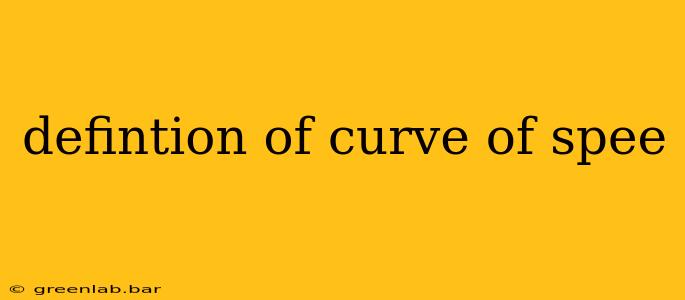The Curve of Spee, a crucial anatomical feature of the human dentition, often sparks curiosity among dental professionals and students alike. Understanding its precise definition, variations, and clinical implications is essential for comprehensive dental practice. This article will delve into the details of the Curve of Spee, exploring its anatomy, significance in occlusion, and its relevance in various dental procedures.
What is the Curve of Spee?
The Curve of Spee is the anteroposterior curvature of the occlusal surfaces of the teeth, viewed from the buccal aspect. Imagine drawing a smooth curve connecting the tip of the canine, through the buccal cusps of the premolars, and finally to the cusp of the most distal mandibular molar. This gentle, sweeping curve is what we define as the Curve of Spee. It's not a perfectly uniform curve in every individual; its form can vary considerably, influenced by several factors we'll discuss later.
It's important to differentiate the Curve of Spee from the Curve of Wilson, which represents the mediolateral curvature of the occlusal surfaces, specifically focusing on the curvature of the buccal and lingual cusps of the posterior teeth, when viewed from above. Both curves, however, play significant roles in the complex mechanics of occlusion.
Understanding the Significance of the Curve of Spee
The Curve of Spee plays a vital role in several key aspects of dental function and occlusion:
-
Efficient Mastication: This curvature facilitates the smooth gliding of the mandible during mastication (chewing). It allows for a coordinated movement of the teeth, contributing to efficient food breakdown.
-
Shock Absorption: The curved arrangement acts as a natural shock absorber, distributing forces evenly across the teeth and temporomandibular joints (TMJs). This helps protect these structures from excessive wear and potential damage.
-
Maintenance of Occlusal Harmony: The Curve of Spee contributes to the overall harmony of the occlusion, ensuring proper intercuspation (fitting together) of the upper and lower teeth. Any significant deviation from the normal curve can disrupt this harmony, potentially leading to various occlusal issues.
-
Guiding Jaw Movements: The Curve of Spee guides mandibular movements during chewing and swallowing, allowing for a controlled and coordinated action.
Variations and Clinical Implications
The curvature of the Curve of Spee is not uniform across individuals. Variations can occur due to:
-
Genetics: Inherited traits significantly influence the development of dental arches and the curvature of the occlusal surfaces.
-
Developmental Factors: Factors like early childhood habits (thumb sucking) and malocclusion can influence the final form of the Curve of Spee.
-
Dental Wear: Over time, natural wear and tear can alter the original shape of the curve.
Significant deviations from the normal Curve of Spee can lead to various clinical problems:
-
Temporomandibular Joint Disorders (TMD): Abnormal occlusal relationships, often associated with altered Curve of Spee, can strain the TMJs, causing pain, clicking, and other symptoms.
-
Premature Wear: Uneven distribution of forces due to an altered Curve of Spee can lead to premature wear of specific teeth.
-
Occlusal Interferences: The disruption of occlusal harmony can lead to occlusal interferences, affecting chewing efficiency and comfort.
Conclusion
The Curve of Spee is more than just an anatomical curiosity; it's a critical component of a healthy and functional occlusion. Understanding its anatomy, significance, and potential variations is vital for dentists and other healthcare professionals involved in the diagnosis and treatment of dental and temporomandibular disorders. Recognizing deviations from the normal curve and their potential impact is essential for implementing appropriate preventive and restorative measures. Further research into individual variations and their implications continues to expand our understanding of this fundamental aspect of human dentition.

